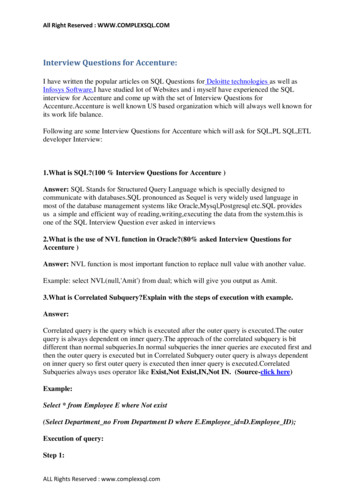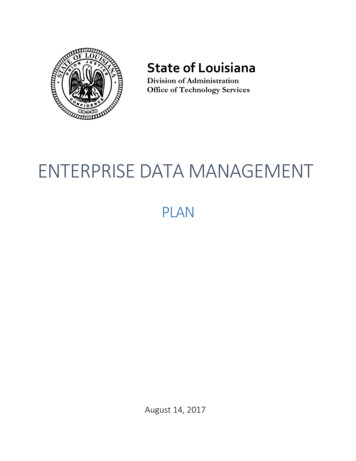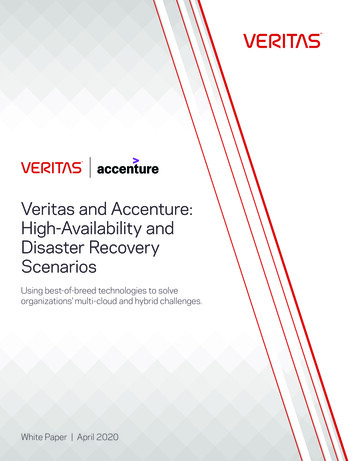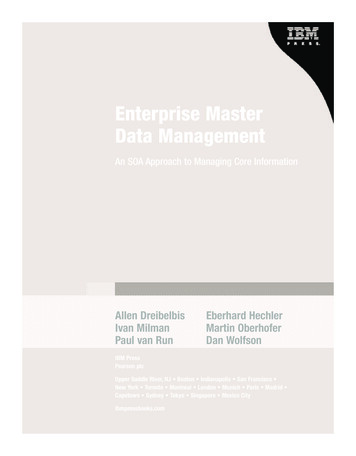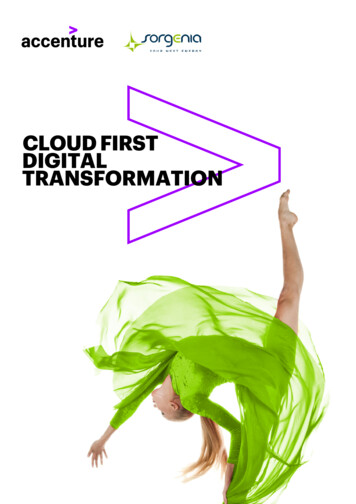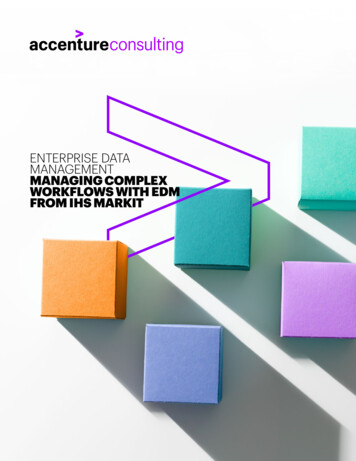
Transcription
ENTERPRISE DATAMANAGEMENTMANAGING COMPLEXWORKFLOWS WITH EDMFROM IHS MARKIT
INTRODUCTIONEnterprise data management (EDM)can be defined as the need to collectdata from multiple sources, masterand validate the data to presenta “gold copy,” and distribute theinformation in a timely fashionto support business activities.EDM activities are often repetitiveand can involve multiple steps.These workflows may be simpleor automated, but sometimes theyare very complex. In deployingworkflows to meet business needs,firms should follow a structuredapproach to avoid the pitfalls anddiversions that can derail thesetypes of initiatives.2 MANAGING COMPLEX WORKFLOWS WITH EDM FROM IHS MARKIT
WHAT IS WORKFLOW?A workflow is a series of connected process steps that encompass operationsand decisions carried out by a person, a group of people or multiple teams.In today’s automated world, machines acrossan organization work together to achievesome desired outcome. In a factory setting,the result might be a completed assembly.In EDM, the outcome is usually a validatedunit of data that’s fit for public consumption.For the purposes of this discussion, we willexclude workflows that are candidates forrobotics process automation (RPA) andfocus on those involving teams of people.Different kinds of workflowsWorkflows can vary considerablyin terms of their scope and complexity.Simple EDM workflows may be used to: Manage data exceptions Create overrides for given valuesAt the other end of the spectrum,complex workflows may be required to: Create new data entities, such as securitiesor portfolios Organize multi-level approvals, such as“four-eyes” approval or cross-departmental/cross-team approval, for overridden valuesAs workflows grow in complexity,tracking, monitoring andeffective communicationbecome increasinglyimportant for confirming thatkey information is passed fromone stakeholder to the next. Organize single approvalfor overridden values3 MANAGING COMPLEX WORKFLOWS WITH EDM FROM IHS MARKIT
IMPLEMENTINGWORKFLOWSRegardless of a workflow’s scope or complexity, several basic but importantdesign principles and development considerations should be followed.Design principlesEnhancing the return on investment ofan EDM system requires a careful look atworkflows within the system and those thatspan the organization, consuming data fromand/or supplying data to the system. All ofthese workflows will play important roles indata governance and stewardship. Whereverpossible, they should facilitate repeatablebusiness processes, process monitoringand automation.Begin the design process by asking: What isthe required outcome? During the discoveryphase of an EDM project, it can be temptingto ask people what they would like to do,but it’s more productive to ask what businessissues need to be addressed.Once specific issues have been identified,review each one in turn: How are things currently done? Why are things done that way? Do the factors or constraints thatled to this process still apply?Take this opportunity to streamline proceduresand introduce operational improvements,but avoid change for the sake of change.Involving end users early is key to thesuccessful design and adoption of newor modified workflows. Each workflowneeds to be designed and written for thetask at hand—how it is actually performed,not how the IT team perceives it to be.A cross-functional team should be chargedwith compiling requirements for meetingthe workflow goals. Once the businessneed and its requirements have beendefined, design and delivery of a newor modified workflow can begin.Involving end users early is keyto the successful design andadoption of new or modifiedworkflows. Each workflow needsto be designed and writtenfor the task at hand—how it isactually performed, not howthe IT team perceives it to be.4 MANAGING COMPLEX WORKFLOWS WITH EDM FROM IHS MARKIT
Development considerationsStoryboarding can be an effective way toinvolve end users in workflow development.Instead of focusing on the precise layout ofscreens in the user interface (UI), this techniqueuses simple, cartoon-like panels to map outand describe the workflow. A single panel mayrepresent an end user’s view of a page in theUI or a step in the process.Storyboarding can help identify: What users need to see What types of actions can be performed What types of validations might be needed What types of actions can be triggeredat this point in the workflowActions identified may include passing thebaton to the next team, initiating backgroundprocessing, triggering requests to otherusers or simply moving on to the next screen.Throughout the process, three questionsshould be revisited often: What needs to be accomplished in this step? What conditions need to be met to move on? What is happening in the background?From an end-user perspective, you mightphrase these as: “What can I see on thescreen?” and “What can I do?”It may be tempting to replicate the currentuser experience to make adoption easier, butthat can lead to an unfortunate mix of front-endcustom development and behind-the-scenestechnical adaptations to meet the agreed-uponbusiness, governance and stewardshiprequirements. The resulting workflowis often difficult and costly to maintain.While UI aesthetics and usability are important,data accuracy is paramount. Use of a workflowdevelopment tool that is tightly coupled withthe EDM environment will help to confirmdata integrity.Workflows should be designed with monitoring,correction activities and performance metricsin mind. Audit monitoring supports the analysisof problems that may arise during workflowexecution. Providing access for correctionactivities allows problems to be remediatedonce their cause is understood. Performancemetrics provide a basis for workflowimprovement over time.A testing plan should be formulated during thedesign and development process. Separationof duties should be strongly enforced,with the creation of a testing team that iscompletely independent of the developmentteam. Tests should reflect agreed-uponbusiness requirements rather than technicalspecifications, which may or may not reflectthe business requirements as well as intended.Requirements change over time, so take thatinto account in the design phase by adoptinga modular approach. Breaking large, complexworkflows into small units makes it possibleto define inputs and outcomes for discreteunits of work. That, in turn, enables smallerunit testing, supports issue resolution andfacilitates future modifications.5 MANAGING COMPLEX WORKFLOWS WITH EDM FROM IHS MARKIT
MANAGINGWORKFLOWS WITHEDM FROM IHS MARKITEDM from IHS Markit is a wellestablished and highly respectedtoolkit that’s capable of meetingmany enterprise data managementneeds—from ingesting data in multipleformats and from multiple sources,to integrating, normalizing, validatingand distributing information.Strong lineage and audit capabilities,combined with a flexible platform,make it a strong choice for numeroususe cases.The EDM from IHS Markit UI development toolsinclude a workflow management componentthat delivers the workflow interface througha standard browser. The workflow componentis a container that supports multiple workflowsteps, maintenance of status information,data integrity and continuity, the ability to callother workflows or processes, and the abilityto navigate forward or backward as indicatedby various status values.EDM from IHS Markit has the distinct advantageof closely integrating workflow managementwith underlying data management as it interactsdirectly with the IHS Markit database and allother Markit components.EDM from IHS Markit has thedistinct advantage of closelyintegrating workflow managementwith underlying data managementas it interacts directly with the IHSMarkit database and all other IHSMarkit components.The nature of the UI structure, which iscomprised of elements placed on pageslinked together using the workflow component,facilitates using a modular approachas described. The data management pipelinecomponents eliminate the temptation to deliversolutions that hide steps within code, insteaddelivering transparent solutions that expose dataand information management at every stage.Although there are limited opportunitiesto vary the look and feel of the workflowUI (e.g., color palette, page layout), theintegration of workflows and data managementcomponents in a common toolkit confirmsconsistency and results in lower ownershipand maintenance costs in the long term.6 MANAGING COMPLEX WORKFLOWS WITH EDM FROM IHS MARKIT
CONCLUSIONOur experience delivering many workflowsacross a wide variety of use cases has reinforcedthe value of the core principles discussedin this paper: start with the business need,use storyboarding to clarify the functionaldesign, develop with the “edge cases” in mind,and test, test, test. Most important, neverforget your end users—they’re the true judgesof a workflow’s usability and value.Through multiple implementations, our teamhas learned how to identify and avoid thepitfalls of EDM from IHS Markit. No systemis perfect, but appropriate experience duringthe design phase can facilitate the platform’sbenefits and reduce its constraints.An appropriately designed solution couldmeet the business needs of both simple andcomplex workflows, while simultaneouslyaddressing the wider needs of monitoringand traceability that data governance andstewardship principles demand. Our teams havethe requisite experience that could be leveragedby your business to yield results which meetyour enterprise data management goals. Alreadytoday, Accenture’s experienced Markit EDMteam currently supports our global clients 24/7.An appropriately designedEDM from IHS Markit solutionwill meet the business needsof both simple and complexworkflows, while simultaneouslyaddressing the wider needs formonitoring and traceability thatdata governance and stewardshipprinciples demand.7 MANAGING COMPLEX WORKFLOWS WITH EDM FROM IHS MARKIT
CONTACTSABOUT ACCENTUREJeremy HurwitzManaging Directorjeremy.m.hurwitz@accenture.comAccenture is a leading global professionalservices company, providing a broad range ofservices and solutions in strategy, consulting,digital, technology and operations. Combiningunmatched experience and specialized skillsacross more than 40 industries and all businessfunctions – underpinned by the world’s largestdelivery network – Accenture works at theintersection of business and technology to helpclients improve their performance and createsustainable value for their stakeholders. Withapproximately 435,000 people serving clientsin more than 120 countries, Accenture drivesinnovation to improve the way the world worksand lives. Visit us at www.accenture.com.Mick CartwrightAssociate Directormick.cartwright@accenture.comBill LeeteManagerbill.leete@accenture.comFollow us on TwitterFollow us on LinkedInRead our BlogExplore more Asset Management Latest ThinkingDISCLAIMERThis content was previously published by InvestTechSystems Consulting. InvestTech is now part of Accenture.This report has been prepared by and is distributed byAccenture. This document is for information purposes.No part of this document may be reproduced in anymanner without the written permission of Accenture.While we take precautions to ensure that the sourceand the information we base our judgments on isreliable, we do not represent that this information isaccurate or complete and it should not be relied uponas such. Opinions expressed herein are subject tochange without notice. This document is not intendedto provide specific advice on your circumstances. If yourequire advice or further details on any matters referredto, please contact your Accenture representative.This document makes descriptive reference to trademarksthat may be owned by others. The use of such trademarksherein is not an assertion of ownership of such trademarksby Accenture and is not intended to represent or imply theexistence of an association between Accenture and thelawful owners of such trademarks.Copyright 2018 AccentureAll rights reserved.Accenture, its logo, andHigh Performance Deliveredare trademarks of Accenture.8 MANAGING COMPLEX WORKFLOWS WITH EDM FROM IHS MARKIT180330
of closely integrating workflow management with underlying data management as it interacts directly with the IHS Markit database and all other Markit components. The nature of the UI structure, which is comprised of elements placed on pages linked together using the workflow comp

